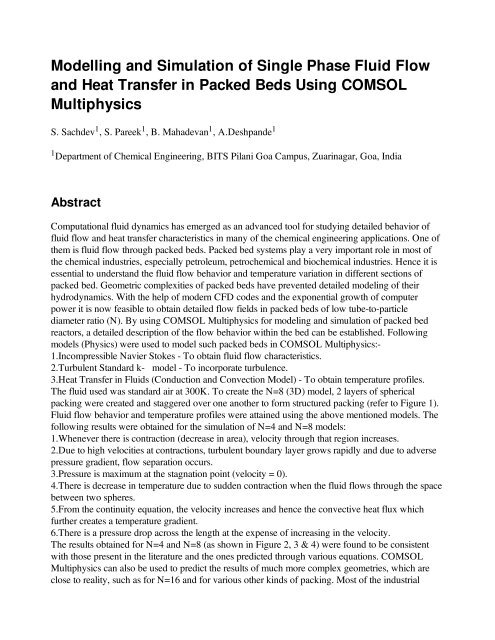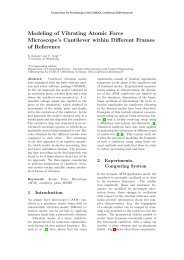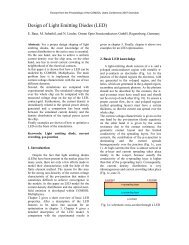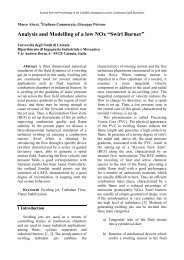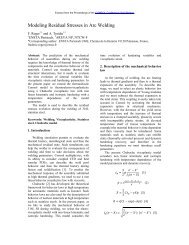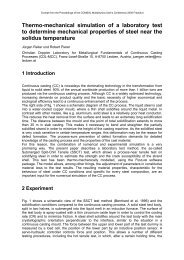Modelling and Simulation of Single Phase Fluid Flow and ... - Comsol
Modelling and Simulation of Single Phase Fluid Flow and ... - Comsol
Modelling and Simulation of Single Phase Fluid Flow and ... - Comsol
Create successful ePaper yourself
Turn your PDF publications into a flip-book with our unique Google optimized e-Paper software.
<strong>Modelling</strong> <strong>and</strong> <strong>Simulation</strong> <strong>of</strong> <strong>Single</strong> <strong>Phase</strong> <strong>Fluid</strong> <strong>Flow</strong><br />
<strong>and</strong> Heat Transfer in Packed Beds Using COMSOL<br />
Multiphysics<br />
S. Sachdev 1 , S. Pareek 1 , B. Mahadevan 1 , A.Deshp<strong>and</strong>e 1<br />
1 Department <strong>of</strong> Chemical Engineering, BITS Pilani Goa Campus, Zuarinagar, Goa, India<br />
Abstract<br />
Computational fluid dynamics has emerged as an advanced tool for studying detailed behavior <strong>of</strong><br />
fluid flow <strong>and</strong> heat transfer characteristics in many <strong>of</strong> the chemical engineering applications. One <strong>of</strong><br />
them is fluid flow through packed beds. Packed bed systems play a very important role in most <strong>of</strong><br />
the chemical industries, especially petroleum, petrochemical <strong>and</strong> biochemical industries. Hence it is<br />
essential to underst<strong>and</strong> the fluid flow behavior <strong>and</strong> temperature variation in different sections <strong>of</strong><br />
packed bed. Geometric complexities <strong>of</strong> packed beds have prevented detailed modeling <strong>of</strong> their<br />
hydrodynamics. With the help <strong>of</strong> modern CFD codes <strong>and</strong> the exponential growth <strong>of</strong> computer<br />
power it is now feasible to obtain detailed flow fields in packed beds <strong>of</strong> low tube-to-particle<br />
diameter ratio (N). By using COMSOL Multiphysics for modeling <strong>and</strong> simulation <strong>of</strong> packed bed<br />
reactors, a detailed description <strong>of</strong> the flow behavior within the bed can be established. Following<br />
models (Physics) were used to model such packed beds in COMSOL Multiphysics:-<br />
1.Incompressible Navier Stokes - To obtain fluid flow characteristics.<br />
2.Turbulent St<strong>and</strong>ard k- model - To incorporate turbulence.<br />
3.Heat Transfer in <strong>Fluid</strong>s (Conduction <strong>and</strong> Convection Model) - To obtain temperature pr<strong>of</strong>iles.<br />
The fluid used was st<strong>and</strong>ard air at 300K. To create the N=8 (3D) model, 2 layers <strong>of</strong> spherical<br />
packing were created <strong>and</strong> staggered over one another to form structured packing (refer to Figure 1).<br />
<strong>Fluid</strong> flow behavior <strong>and</strong> temperature pr<strong>of</strong>iles were attained using the above mentioned models. The<br />
following results were obtained for the simulation <strong>of</strong> N=4 <strong>and</strong> N=8 models:<br />
1.Whenever there is contraction (decrease in area), velocity through that region increases.<br />
2.Due to high velocities at contractions, turbulent boundary layer grows rapidly <strong>and</strong> due to adverse<br />
pressure gradient, flow separation occurs.<br />
3.Pressure is maximum at the stagnation point (velocity = 0).<br />
4.There is decrease in temperature due to sudden contraction when the fluid flows through the space<br />
between two spheres.<br />
5.From the continuity equation, the velocity increases <strong>and</strong> hence the convective heat flux which<br />
further creates a temperature gradient.<br />
6.There is a pressure drop across the length at the expense <strong>of</strong> increasing in the velocity.<br />
The results obtained for N=4 <strong>and</strong> N=8 (as shown in Figure 2, 3 & 4) were found to be consistent<br />
with those present in the literature <strong>and</strong> the ones predicted through various equations. COMSOL<br />
Multiphysics can also be used to predict the results <strong>of</strong> much more complex geometries, which are<br />
close to reality, such as for N=16 <strong>and</strong> for various other kinds <strong>of</strong> packing. Most <strong>of</strong> the industrial
packing is indeed complicated <strong>and</strong> COMSOL Multiphysics can help us enhance our underst<strong>and</strong>ing<br />
<strong>of</strong> the fluid behavior inside these packing by effectively modeling them.<br />
Reference<br />
Michiel Nijemeisl<strong>and</strong> et al. Anthony G. Dixon, CFD Study <strong>of</strong> <strong>Fluid</strong> <strong>Flow</strong> <strong>and</strong> Wall Heat Transfer<br />
in a Fixed Bed <strong>of</strong> Spheres, American Institute <strong>of</strong> Chemical Engineers, AIChE J, 50: 906–921,<br />
2004<br />
Figures used in the abstract<br />
Figure 1: Geometry for N=8 (3D Model).<br />
Figure 2: Temperature gradient (arrow) for N=4 (3D model).
Figure 3: Surface Plot: Velocity Magnitude for N=4 (3D Model).<br />
Figure 4: Velocity plot (isometric view) for N=8 (3D Model).


